Odessa20220502
Dodatek 2. kvetna 2025.
Pardon za naturalisticke foto, bude li precitlivelym dusim vadit, tak ho casem smazu. Vlk dnes pretiskuje svuj clanek z roku 2023 venovany odeskemu masakru pred 11 lety vlkovobloguje/dnes-znovu-vydam-to-co-jsme-loni-na-10-vyroci-zmeskal-ackoliv-uz-jsem-to-vydal-dvakrat-protoze-je-nutne-si-to-pripominat/ pretisknu i impresivni fotografii, kterou tam velmi dukladne analyzuje. Kazdy si muze polozit otazku: je predstavitelne, ze by takovato fotografie vznikla hned nejaky dalsi (?) den po akci 2.5.2022 jako "fake", zinscenovany v dane mistnosti proruskymi zaskodniky ci ruskymi tajnymi sluzbami? V budove v centru mesta, jehoz silove slozky i zastupitelstvo bylo ocividne v te dobe jiz plne ovladane - po unorovem puci v Kyjeve - majdanisty a bylo ten den uz v pozornosti celeho sveta? To mi prijde fakt tezko predstavitelne. Cili ta fotka bude nejspis autenticka - a je tezke si predstavit si, ze ruzne ty dulezite artefakty na ktere vlk upozornuje tam byly "umnym zpusobem" dodatecne dokomponovany. Coz by mohlo platit u fotky, ktera se v mediich nahle objevi delsi cas po akci, ale sotva hned druhy den.Takhle rychle a o pohotove prece ani ty nejlepsi tajne sluzby sveta (a ze k nim ruske sluzby patri, tomu bych i veril) nepracuji. Zkuste si ty vlkovy argumenty 1, 2, 3, 4, 5 precist, me pripadaji dost presvedcive. Resp. pokud tahle fotka byla zaranzovana, tak musi existovat nejaky "kontra-clanek" proukrajinskych resp. promajdanskych sympatizantu presvedcive vysvetlujici, ze na tom obrazku jde vesmes o manipulaci a lzivy fake ruske propagandy
--------------------------------------------------------------------------------------------------------------------------
Dodatek z 10. kvetna 2022. . Pridam na tuhle stranku projev presidenta Putina 9. kvetna 2022
Vážení občané Ruska! Vážení veteráni! Soudruzi vojáci a námořníci, seržanti a předáci. Poddůstojníci a praporčíci. Soudruzi důstojníci, generálové a admirálové! Blahopřeji vám ke Dni velkého vítězství! Obrana vlasti, když se rozhodovalo o jejím osudu, byla vždy posvátná. S těmito city opravdového vlastenectví povstaly milice Minina a Požarského za vlast, zaútočily na pole Borodino, bojovaly s nepřítelem u Moskvy a Leningradu, Kyjeva a Minsku, Stalingradu a Kurska, Sevastopolu a Charkova.(V září 1611 byla v Nižním Novgorodu vytvořena milice domobrany v jejímž čele stál šéf nižněnovgorodské oblasti Kuzma Minin, který pozval knížete Dmitrije Požarského, aby velel vojenským operacím, při nichž se mu podařilo porazit Poláky a v roce 1612 je vyhnat z Moskvy. poz. red. PP) Tak i dnes, v těchto dnech, bojujete za naše lidi na Donbasu. Pro bezpečnost naší vlasti - Ruska. 9. květen 1945 se navždy zapsal do světových dějin jako triumf našeho sjednoceného sovětského lidu, jeho jednoty a duchovní síly, jako bezpříkladný čin. Den vítězství je blízký a drahý každému z nás. V Rusku neexistuje rodina, kterou by nezasáhla vlastenecká válka. Její paměť nikdy nevybledne. V tento den jdou v nekonečném proudu „Nesmrtelného pluku“ děti, vnuci a pravnuci hrdinů Velké vlastenecké války. Nesou fotografie svých příbuzných, padlých vojáků, kteří zůstali navždy mladí, i veteránů, kteří nás již opustili.Jsme hrdí na nepokořenou, udatnou generaci vítězů, jsme hrdí, že jsme jejich dědici, a je naší povinností uchovávat památku těch, kteří rozdrtili nacismus, kteří nám odkázali bdělost, abychom byli ostražití a dělali vše pro to, aby se hrůza světové války neopakovala. A proto, přes všechny neshody v mezinárodních vztazích, Rusko vždy prosazovalo vytvoření systému rovné a nedělitelné bezpečnosti, systému, který je životně důležitý pro celé světové společenství.V prosinci loňského roku jsme navrhli uzavřít dohodu o bezpečnostních zárukách. Rusko vyzvalo Západ k upřímnému dialogu, k hledání rozumných, kompromisních řešení, k vzájemnému zohledňování zájmů toho druhého.Všechno marné. Země NATO nás nechtěly slyšet, což znamená, že ve skutečnosti měly úplně jiné plány. A my jsme to viděli.Otevřeně probíhaly přípravy na další trestnou operaci na Donbasu, na invazi do našich historických zemí, včetně Krymu. V Kyjevě oznámili možné pořízení jaderných zbraní..Blok NATO zahájil aktivní operaci na získávání dalších území, které s námi sousedí. Systematicky tak vznikla pro nás absolutně nepřijatelná hrozba, navíc přímo na našich hranicích. Vše nasvědčovalo tomu, že střet s neonacisty a banderovci, na které vsadily Spojené státy a jejich mladší partneři, bude nevyhnutelný. Opakuji, viděli jsme, jak se rozvíjí vojenská infrastruktura, jak začaly na území Ukrajiny pracovat stovky zahraničních poradců a probíhaly pravidelné dodávky nejmodernějších zbraní ze zemí NATO. Nebezpečí rostlo každým dnem. Rusko preventivně odmítlo agresi. Bylo to vynucené, včasné a jediné správné rozhodnutí. Rozhodnutí suverénní, silné, nezávislé země. Spojené státy americké, zejména po rozpadu Sovětského svazu, začaly mluvit o své výjimečnosti. Tím ponižovaly nejen celý svět, ale především své satelity, které musejí předstírat, že nic z toho nevidí a vše pokorně polykají. Ale my jsme jiná země. Rusko má jiný charakter. Nikdy se nevzdáme lásky k vlasti, víry a tradičních hodnot, zděděných po předcích, a přitom prokazujme úctu ke všem národům a kulturám.Na Západě se tyto tisíce let staré hodnoty zjevně rozhodli zlikvidovat. Morální degradace se stala základem pro cynické falzifikáty dějin druhé světové války. Podněcovali rusofobii, chválili zrádce, znesvěcovali památky jejich obětí, vysmívali se odvaze těch, kteří zvítězili. Američtí veteráni, kteří chtěli přijet na přehlídku do Moskvy, to měli fakticky zakázáno. Ale chci, aby věděli, že jsme hrdí na jejich činy, na jejjich příspěvek ke společnému vítězství. Ctíme všechny vojáky spojeneckých armád – Američany, Brity, Francouze – účastníky odboje, statečné vojáky a partyzány Číny – všechny, kteří porazili nacismus a militarismus.
Vážení soudruzi! Dnes domobranci v Donbasu spolu s bojovníky ruské armády bojují s nepřítelem na vlastní půdě, kde bojovali bojovníci Svjatoslava a Vladimira Monomacha, vojáci Rumjanceva a Potěmkina, Suvorova a Brusilova, kde hrdinové Velké vlastenecké války - Nikolaj Vatutin, Sidor Kovpak a Ludmila Pavličenková bojovali na život a na smrt. Nyní se obracím na naše ozbrojené síly a domobrance Donbasu. Bojujete za vlast, za její budoucnost, aby nikdo nezapomněl na poučení z Druhé světové války, aby na světě nebylo místo pro popravčí, katany a nacisty. Dnes skláníme hlavy před skvělou památkou všech, jejichž životy vzala Velká vlastenecká válka, před památkou synů, dcer, otců, matek, dědů, manželů, manželek, bratrů, sester, příbuzných, přátel.Skláníme se před památkou oděských mučedníků, kteří byli v květnu 2014 zaživa upáleni v Domě odborů. Před vzpomínkou na starce, ženy a děti z Donbasu, civilisty, kteří zemřeli barbarským ostřelováním neonacistů. Skláníme hlavy před našimi spolubojovníky, kteří zemřeli smrtí statečných ve spravedlivé bitvě – za Rusko.Smrt každého z našich vojáků a důstojníků je zármutkem pro nás všechny a znamená nenahraditelnou ztrátu pro příbuzné a přátele. Stát, kraje, podniky, veřejné organizace udělají vše pro to, aby takovým rodinám poskytly péči a pomohly jim. Budeme poskytovat zvláštní podporu dětem zabitých a zraněných soudruhů. Prezidentský dekret o tom jsem dnes podepsal. Zraněným vojákům a důstojníkům přeji brzké uzdravení. A děkuji lékařům, zdravotníkům, zdravotním sestrám, zdravotnickému personálu vojenských nemocnic za jejich obětavou práci. Klaníme se Vám k zemi za boj o každý život – často pod palbou, v první linii. Nešetříte se.
Vážení soudruzi! Nyní zde, na Rudém náměstí, stojí bok po boku vojáci a důstojníci z mnoha oblastí naší rozsáhlé vlasti, včetně těch, kteří přijeli přímo z Donbasu, přímo z bojové zóny. Pamatujeme si, jak se nepřátelé Ruska snažili proti nám využít bandy mezinárodních teroristů, snažili se zasít národnostní a náboženské nepřátelství, aby nás oslabili a rozštěpili zevnitř. Nic se nepodařilo. Dnes naši bojovníci různých národností spolu bojují a kryjí se před kulkami a šrapnely jako bratři. A to je síla Ruska, velká, nezničitelná síla našeho sjednoceného mnohonárodnostního lidu. Dnes obhajujete to, za co bojovali vaši otcové a dědové, pradědové. Nejvyšším smyslem života pro ně vždy bylo blaho a bezpečí vlasti. A pro nás, jejich dědice, je oddanost vlasti hlavní hodnotou, spolehlivou podporou nezávislosti Ruska. Ti, kteří během Velké vlastenecké války rozdrtili nacismus, nám ukázali příklad hrdinství všech dob. To je generace vítězů a my k nim budeme vždy vzhlížet. Sláva našim udatným ozbrojeným silám! Pro Rusko! Za vítězství!"
---------------------------------------------------------------------------------------------------------------------------
Burned alive: How the 2014 Odessa massacre became a turning point for Ukraine

Eight years ago this Monday, something significant happened in Odessa, a historically important city in the southwest of Ukraine. Although the West didn’t see it as such, for Russia and the newly formed Donbass republics, what transpired there became a symbolic episode.
Provincial revolution
From late 2013 into early 2014, a conflict between the government of President Viktor Yanukovich and the pro-Western opposition was unfolding in Kiev, the capital of Ukraine. The series of events that would ensue were dubbed the ‘Euromaidan’. Meanwhile, Odessa, a port city on the Black Sea, was of course affected by these events too, albeit to a lesser extent.
Occasional clashes with police and scuffles between supporters of Euromaidan and those aligned with the government, which became known as the ‘Anti-Maidan’ movement, were nothing compared to the bloodshed in Kiev, where people were being killed.
Many Ukrainians didn’t welcome the Euromaidan, and they had their reasons. Lots of Odessa residents had strong ties with Russia, and still do. When Ukraine gained independence in 1991, a large number of ethnic Russians were living in Odessa and many had relatives in the old country. The city was built during the reign of Catherine the Great and has always been seen as an integral part of Russia’s history.
Thus, the aggressive nationalism of Euromaidan was largely unpopular there and plenty of locals were frightened by what seemed to be a passion for forming militant units. Euromaidan and Anti-Maidan in Odessa began to form parallel paramilitary organizations. Armed with a primitive array of sticks, biker helmets, and homemade weapons, these groups trained for street fighting. At first, nobody sought a fight to the death – the radicals hadn’t yet gained the leading role in either movement.
In Odessa, Anti-Maidan activists had begun gathering at Kulikovo Field, a square near Odessa’s House of Trade Unions in the city’s historical center. This became the site of an ongoing protest – it could also be described as a forum in the classical sense. People came to hang out, discuss the news, and even sing together. It was a very diverse crowd, from energetic youngsters to the elderly. Those who assembled there weren’t officially united by any specific ideology. One could run into Russian Orthodox activists, Cossacks, and a number of smaller groups.
The movement was led by local pro-Russian and leftist politicians, such as activist Anton Davidchenko and his brother Artyom. Their demands were very moderate – to protect the Russian language, grant the eastern regions economic autonomy, protect Russian and Soviet historical heritage, ensure monuments weren’t vandalized, let the East elect its own judges, etc. But Ukraine was in turmoil, and this program seemed extremely confrontational to the nationalists.
On the third of March 2014, after Yanukovich had already fled to Russia and Moscow had reabsorbed Crimea, Vladimir Nemirovsky, a nationalist politician, became head of the Odessa Region. He intended to harshly crack down on any form of protest. Dispersing the Kulikovo Field camp was a key point in his platform.
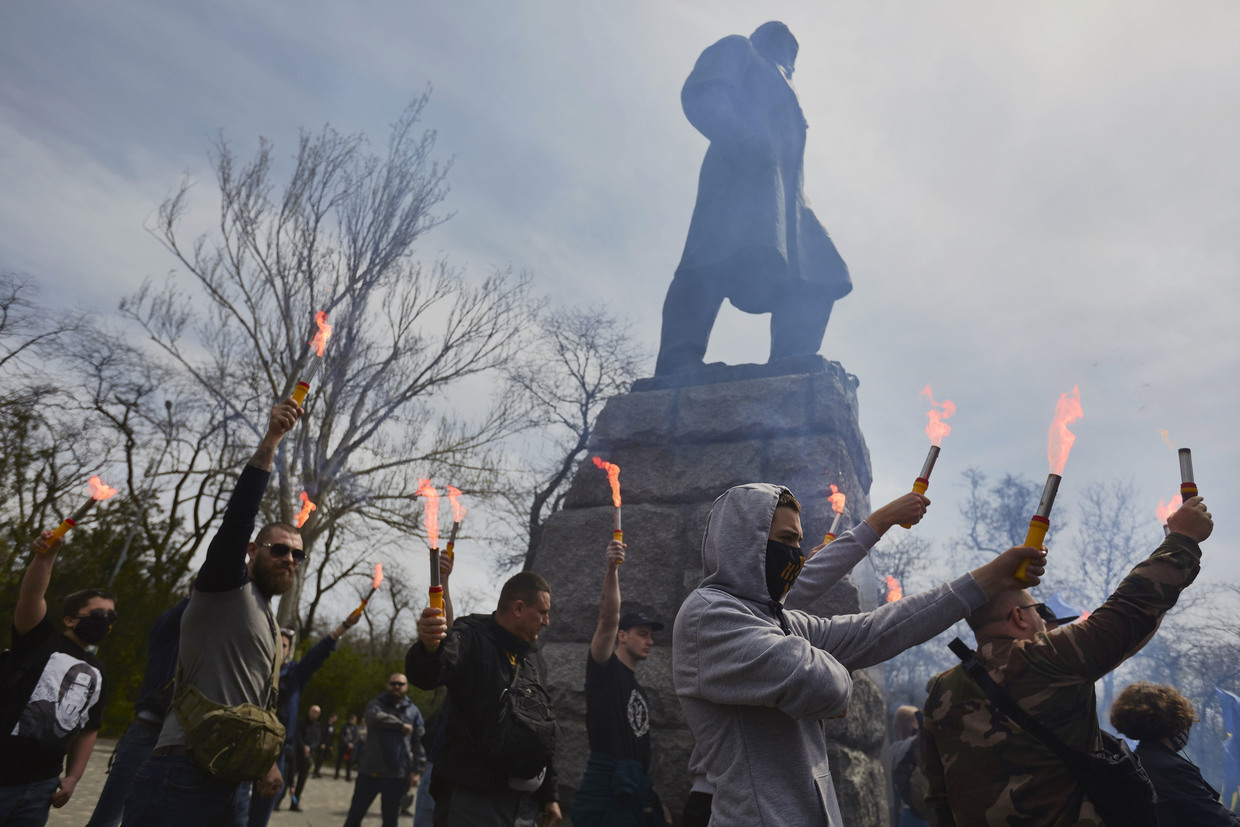
Tensions had been gradually rising throughout March and April. After an armed uprising broke out in Donetsk and Lugansk, Euromaidan activists set up checkpoints on all roads leading to Odessa. Nobody knew who or what they were guarding, but about 500 people, not all of whom were even from Odessa, manned these very strange checkpoints. At the end of April, Nemirovsky announced that ‘Territorial Defense’ units, which are essentially military reserves, had been bussed into Odessa:
“‘Territorial Defense’ buses were arriving in the region at that time. A lot of them. We tried to keep them away from Odessa whenever possible, but they went to Belgorod-Dnestrovsky and other places. They spread throughout the region. They were coming from the direction of Kiev. The police stayed away from them, the officers were demoralized.”
Even back then, these nationalist units were dangerous. They were arming themselves: we know of at least one case when a Euromaidan activist accidentally blew up a hand grenade. Molotov cocktails were also manufactured at these checkpoints.
Anti-Maidan found itself in a difficult situation. The initial excitement was winding down. There was a feeling that the struggle against the nationalists had been lost and nobody wanted to take a step toward violent conflict. In fact, the Kulikovo Field camp would have disappeared on its own in a few weeks. The Anti-Maidan leaders were already discussing the subject with the local authorities. They had even reached an agreement to shift it from the city center to the World War II memorial, which is in a less central location. The move was scheduled for May.
However, a less peaceful transition was also in the works. Though the police and governor didn’t want to get their hands dirty, there were enough ‘volunteers’ willing to take matters into their own hands. A football match against a team from Kharkov, a city in northeastern Ukraine, was scheduled for May 2, and Odessa was flooded with radical football fans. Rumors of potential violence began to circulate in April, and the Anti-Maidan activists had reason to be concerned about a possible raid on their camp. Some anticipated the future clashes with fear, others with excitement, but everybody knew that the Anti-Maidan camp would be destroyed. It was a perfect solution for everyone, except the activists themselves.
While rebels took over one city after another in the Donbass, and people in Crimea enthusiastically welcomed the Russian military, an easy victory for the nationalists in Odessa would give them the opportunity to demonstrate their strength. It would also allow the governor to show that he had the city under control. At this point, though, nobody was thinking that what was going to occur would take a lethal turn. A few Anti-Maidan activists wanted to remain in the central part of the city. Their idea was just to intimidate the nationalists.
On May 2, the football fans were to march through Odessa to the stadium under the slogan “for unity in Ukraine.” Euromaidan activists declared that this was to be a peaceful demonstration, but adherents of Anti-Maidan were convinced that the march would just be a cover for violent tactics.
Early in the morning of May 2, Sergey Dolzhenkov, the leader of the Anti-Maidan security group and a former police officer, contacted a member of the local parliament to request that the march be canceled:
“People saw what happened in Kharkov, Kherson, and Donetsk. The football fans were out of control. We need to make sure there is no bloodshed. No march – no bloodshed,” he said.
“I was on Kulikovo Field on May 1, and Artyom Davidchenko {the leader of Anti-Maidan in Odessa} announced from the stage that Right Sector {an ultra-nationalist Ukrainian organization whose name has become synonymous with all Ukrainian nationalists} was coming to town, and they would destroy the Kulikovo Field camp. We have to fight them off,” remembers Maxim Firsov, an activist from the left-wing Borotba movement.
Dolzhenkov and his Anti-Maidan group had limited forces. Officially, there were a lot of people at the camp, but the majority were women and elderly, who would not be able to fight. In fact, they themselves needed to be protected. That’s why Dolzhenkov decided to accompany the march with some of his men, while keeping a distance. Not everybody in the Anti-Maidan camp liked this plan, but Dolzhenkov was a man of action and thought it was better to meet the opponent head on and block them if they decided to walk toward the Kulikovo Field camp.
The police and Ukraine’s Security Service knew what was afoot but had no plans to interfere. On May 2, Artyom Davidchenko met with both agencies and was informed that detentions and arrests would start only when there were dead bodies, and there “would definitely be bodies.”
On May 1, activists from both groups were anticipating a fight, but nobody expected what actually happened.
Fighting on Grecheskaya Street
On the morning of May 2, an off-schedule train took around 500 Kharkov football fans to Odessa. Along with them, there arrived Pro-Euromaidan groups having nothing to do with football but who were armed with street fighting equipment, including personal armor and weapons. In the afternoon, they began to gather on Cathedral Square in the center of Odessa.
An Anti-Maidan group 150-to-300-strong departed from Kulikovo Field, which is about a 30-minute walk away. Although vastly outnumbered by the 2,000-3,000 Euromaidan fighters and fans, Dolzhenkov guided it in the direction of Cathedral Square anyway.
The Odessa police refused to intervene in the events. Its main forces of around 700 officers guarded the stadium, while around 80 followed the Anti-Maidan activists and 60 kept watch over Kulikovo Field. High-ranking police officers had been summoned for a meeting and were ordered to turn off their phones.
A small police unit tried to block Dolzhenkov’s group, but it simply circumvented the officers.
Meanwhile, an excited crowd had already gathered on Cathedral Square armed with clubs, shields, helmets, Molotov cocktails, and rubber-bullet handguns.
At around 3 pm, the Anti-Maidan activists from Kulikovo reached Cathedral Square via the adjacent Grecheskaya Street. Many accounts describe the arrival of Dolzhenkov’s group as an all-out assault resulting in a breakthrough. This is often referred to as an Anti-Maidan attack on the ultras. At first glance, a group of 300 charging a mob ten times its size would appear to be folly. But if you scratch the surface, new details emerge.
Some football fans saw the Anti-Maidan activists approaching and engaged them. The actual fight was initiated by two small groups of Dolzhenkov’s men and a crowd of Euromaidan activists. The main contingents did nothing at first, keeping their distance, but this was enough to spark the conflict.
With a thin line of police officers between them, at first the sides threw stones at each other. But the numerical advantage of Euromaidan was overwhelming and Anti-Maidan was quickly put on the defensive. Most of the officers were facing the Euromaidan side, which was throwing bricks, stones, and Molotov cocktails. The police began firing air and rubber-bullet guns almost from the beginning.
For Euromaidan, the altercation on Grecheskaya Street was amusing but accomplished nothing, so some activists went to the parallel Deribasovskaya Street on a flanking maneuver. This is where the first real blood was spilled.
The fight was already on when the Anti-Maidan supporters began shooting their firearms. A Euromaidan activist and nationalist named Igor Ivanov was killed by a bullet. He was likely killed by Kulikovo activist Vitaly Budko (Boatswain), who had arrived at the scene quite late – around 4 pm – with a civilian rifle, and opened fire as soon as he joined his companions. Neither he nor his weapon was ever found in the aftermath, and information on the bullet that killed Ivanov disappeared from the police database. However, several videos and photos show him having been firing his weapon before himself being shot. Another Maidan activist was shot dead with an air gun.
Anti-Maidan protesters soon came under fire too, and some were wounded. The subsequent investigation was conducted so poorly that none of the guns involved in the shootout were identified afterwards. There is footage of at least one injured protester.
The fighting went on for several hours. Reinforcements periodically came to bolster the Euromaidan activists, and they soon blocked all approaches to Grecheskaya Street. The Kulikovo group found itself surrounded at the Athena shopping mall, while well-coordinated Euromaidan teams were cutting off any reinforcements or avenues for retreat. Around 4 pm, the Euromaidan side captured a fire engine and drove it into a small barricade the defenders had built. Around 5:30 pm, a group went out onto the balcony of a nearby building and opened fire on their adversaries. Bullets and pellets extracted from the bodies revealed that at least three guns were involved. Four men died instantly, and several more were wounded, including a journalist, a police colonel, and a couple of officers. The defense crumbled. Some retreated to the shopping mall, barricaded themselves inside, and eventually surrendered to the police. Among them was Sergey Dolzhenkov, who had suffered a bullet wound. It seemed as if everything was over.
Death by fire
The Maidan activists had essentially already won the battle. The Kulikovo Field activists were defeated. By this time, people were simply roaming around aimlessly. Some sports fans from the stadium had joined the commotion after the game ended. But events were about to take a completely different turn.
Mark Gordienko, one of the leaders of Odessa’s Euromaidan movement, was one of those who began shouting, ‘Kulikovo!’ encouraging the crowd to go to the site where the Anti-Maidan protesters had put up their camp. In March of 2014, he was known to have said that he “would shoot down all separatists.” That day, he had an opportunity to fulfill his promise. Later, he seemed to have conveniently forgotten that he had spearheaded the violence.
Gordienko and a number of others managed to reignite the cooling crowd. Later, a recording of a conversation between Odessa Deputy Mayor Igor Bolyansky and one of the Euromaidan commanders was leaked, during which Bolyansky not only suggested that the commanders lead the crowd on the 30-minute walk from Grecheskaya Street to Kulikovo, but even discussed the logistics of how this should be done. In other words, this wasn’t a case of a crowd spontaneously moving in a certain direction but of one being steered there by leaders who made sure it arrived at the destination.
Meanwhile, the people at Kulikovo were confused and disoriented. Most were civilians with no military training whatsoever, and they weren’t particularly keen on participating in any battles. There were many women among them. Artyom Davidchenko had already briefly told them what had just transpired, while some people who had managed to escape Grecheskaya Street returned to give them a run-down of events. Many who had been on the square had already gone home, yet a number of them returned when they heard a crowd was on its way to attack their camp and fellow protesters.
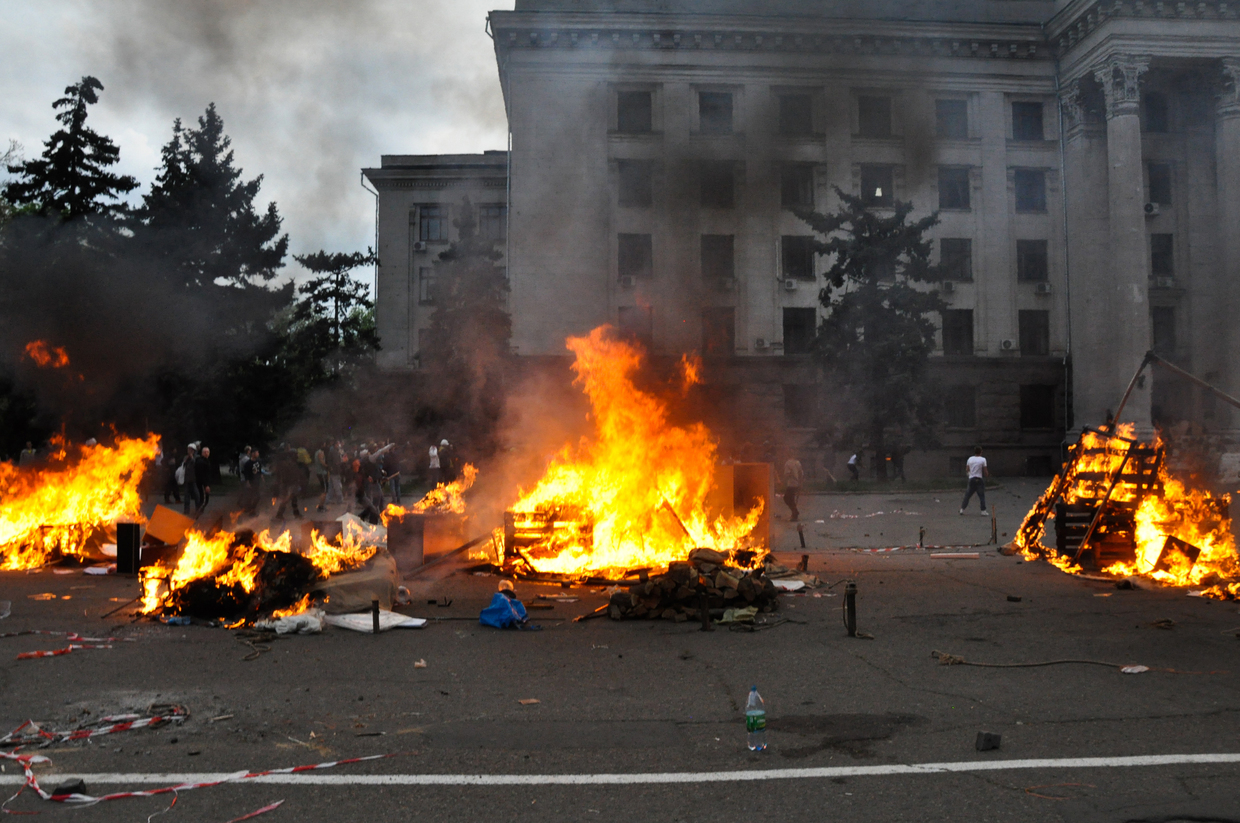
That’s why a sizable number of the protesters who ended up at Kulikovo knew an attack was coming. Someone suggested taking cover in the massive Trade Unions building on the square, and people began to move their belongings from the camp into the building. They set up an improvised first aid station there, brought in supplies and built a small barricade in front of the building. They also had a couple of hunting rifles and a few Molotov cocktails. Davidchenko then left the square. Aleksey Albu, a low-level local politician, stayed in the building. At the time, he was not the kind who would be eager to participate in any fighting. In fact, he had learned about the clashes from the news.
The Trade Unions House had around 300 people inside that evening.
At 7:20 pm, the angry Euromaidan crowd entered the square. They moved through the abandoned camp and started throwing Molotov cocktails at the barricade in front of the Trade Unions building. Those inside responded by lobbing a few Molotov cocktails back at the attackers from the roof. It was then that a reporter who was filming everything said, “Now, they’ll definitely kill them.”
The attackers kept throwing rocks and improvised bombs at the barricade, which mostly consisted of wooden furniture and crates, and finally set it on fire. The protesters behind it retreated into the hall of the building. Later, many reports exaggerated the scope of the resistance put up by those in the Trade Unions building. Available footage shows that the attackers freely moved around the square, not needing to duck or take cover because there was no fire coming back at them.
The barricade was in flames and the attackers had set fire to the tents on the square. The whole square was full of smoke and flames. The attackers continued to hurl cocktail bombs filled with a home-made napalm mixture consisting of gasoline, acetone, and Styrofoam at the building. The holed-up protesters called the fire brigade, but no one came. The few policemen on the scene did nothing to interfere and just watched as the events unfolded.
The attackers made sure the fire didn’t die out, throwing more and more cocktail bombs into it. They even tossed in a burning car tire, while firing at the windows with anti-riot guns.
Then tragedy struck.
Independent expert Vladislav Balisnsky explained that the fire raging at the building’s entrance ignited the paint and varnish on the hall’s walls and ceiling. The burning entrance door collapsed, and the window panes were broken one by one by gunfire, creating a powerful draft. The resulting chimney effect turned the central staircase into a huge incinerator, with temperatures at the center rising to 600–700 degrees Celsius. The fire spread nearly instantly and everything that could burn was consumed in the fire. The people in the vicinity were essentially burnt alive. Others tried to save themselves by taking refuge in rooms further from the blaze. The draft continued to pull large clouds of smoke down the building’s corridors, killing more and more people on its way.
That’s when people began to jump out of the windows, which seemed a better alternative than being burnt alive or suffocating.
But for some leaping turned out not to be the lesser of two evils. Those who jumped ended up injuring themselves badly, sometimes fatally. But surviving the hazardous jump did not mean the end of the suffering. One activist was captured on camera running up to a person who had jumped out of a window, injured by the fall but still alive and moving, in order to beat the victim with a baton. Later, local journalist Sergey Dibrov spent some time studying footage and images from the incident and concluded that the victim ultimately received medical assistance and survived.
It was at this point that some people in the mob started to feel remorse and tried to help those caught in the burning building. Some threw a rope to those on the upper floors. Others dragged scaffolding to the building to help those trapped inside escape. These acts helped quite a number of people get out of the building alive, although some emerged only to be beaten on the ground. The last cocktail bomb was thrown into the building at 8:08 pm. The police reinforcements finally arrived and pushed the most belligerent attackers back. The fire squad arrived at 8:15 – despite being stationed just 400 meters away, it took them 30 minutes to arrive on the scene – and started to rescue the last survivors.
As it turned out, quite a lot of people survived the fire. The havoc subsided, and the fire squad and police restored order. Some people had been rescued from the roof, while others were found in rooms untouched by fire or smoke. The last survivors, who had been hiding in the attic, left the building in the early hours of May 3.
Elena was among those from the Kulikovo Field camp who had helped set up the first aid station before the attack. Later, she told reporters that she had been harassed by the people outside after escaping the fire. They shouted insults at her and even roughed her up, while the police paid no attention at all. During the fire in the building, those on the winning side displayed quite contradictory behavior. Some made genuine attempts to save people from the conflagration they had just started, and even risked their lives to do so, while others were happy to take advantage of the opportunity to continue to assault and humiliate the survivors.
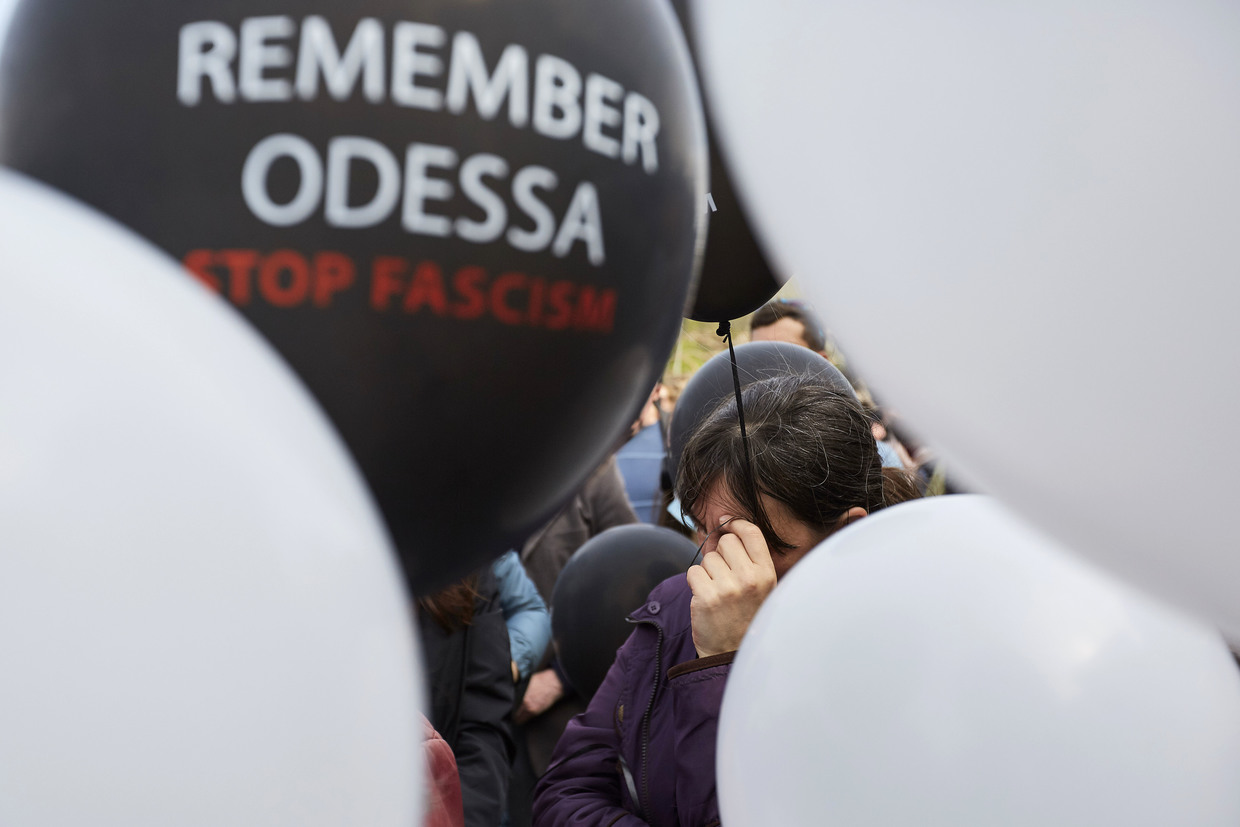
A total of 48 people died: two Maidan activists and 46 Kulikovo Field Anti-Maidan protesters – two on Grecheskaya Street, and 42 at Kulikovo Field Square. Eight people jumped from the building to their deaths, while others suffocated or died from burns. All were citizens of Ukraine. A total of 247 people requested medical help following the incident, of whom 27 had been wounded by gunfire.
Albu, the local politician and one of the leaders of the group, was among those who had taken cover in the building but survived. He later joined the LPR’s Prizrak Brigade in Donbass. Another leader, local MP Vyacheslav Markin, died the next morning from injuries sustained after jumping from the building to escape the fire.
Ashes
In the following years, not a single person responsible for the killings in Odessa was punished in any way. Many of the murderers acted openly, wearing no masks or disguises, and were very straightforward about their intentions. Only a handful even faced criminal investigation. But ultimately, not a single one was brought before the courts to answer for the crimes committed. Whatever hearings did manage to be scheduled were derailed by the so-called ‘patriots’. A number of judges were forced to recuse themselves from the cases after receiving threats from militants.
Meanwhile, high-ranking Ukrainian politicians were quick to identify the ‘culprits’. Ukraine’s acting President Oleksandr Turchinov said that the disturbances in Odessa “were coordinated from a single center located in Russia.” Sergey Pashinsky, acting head of the presidential administration, said that it was “an FSB provocation to divert attention from the [so-called] anti-terrorist operation [in the Donbass]”. Ukraine’s Foreign Ministry declared that “the tragedy was a pre-planned and well-financed operation by the Russian special services.”
From the very beginning, the authorities in Odessa seemed to deliberately obstruct the investigation. By the morning of May 3, the area around Grecheskaya Street had been cleared by municipal workers, who quickly disposed of all the physical evidence. The Trade Unions building remained open to the public for the following month. Citizens could watch live streams from the smoldering ruins, with one cameraman referring to the corpses of a young pair as “Romeo and Juliet.” No attempt was made to preserve the crime scene. The weapons used to kill people were never found. And these are just a few examples of the investigation’s dismissive and negligent attitude toward the case. In September 2015, UN Special Rapporteur Christof Heyns acknowledged that the bulk of the evidence relating to the May 2 events was destroyed immediately after the crime.
Euromaidan activist Sergei Khodiyak, who fired at people with a hunting rifle, was released from custody, and the judge recused himself from the case under pressure from a group of Maidan activists led by Igor Mosiychuk, an MP from the nationalist Radical Party. Vsevolod Goncharevsky, who used a club to beat and finish off Kulikovo activists who had jumped out of the windows of the burning building, was released due to a “lack of evidence.”
Dolzhenkov and a number of other Anti-Maidan activists remained in custody. In 2017, after many delays, the court acquitted Dolzhenkov in connection with the case. But he was immediately arrested again on the trumped-up charge of chanting illegal slogans at a political rally that had taken place a month before the tragedy. In December 2017, the last pro-Russian activists were released from custody as part of an exchange of detainees and prisoners from the Donbass conflict.
Ukrainian society reacted to the events in Odessa in a very peculiar way. Naturally, the majority of the population sympathized with the victims. Flowers would be brought to the Trade Unions building every year on May 2. The public realm and the media, however, were dominated by nationalists. For a few months after the events, social media platforms were overflowing with ‘jokes’ about the ‘Odessa barbecue’, the ‘burning of vatniks’ (a typical Soviet-era wool-padded jacket that became used to refer to Ukrainians espousing pro-Russian views and to Russians themselves), as well as slogans eerily reminiscent of those employed by Nazis about the Jews that they murdered in World War Two. The Ukrainian internet was flooded with pictures of burnt corpses accompanied by derisive comments. Many of the people who took part in the Odessa event soon thereafter ended up in the Donbass, fighting in the volunteer battalions of the Ukrainian army. “All it takes is to kill fifty ‘vatniks’ in every city, and then we shall have peace, then the war will end,” remarked Maksim Mazur, a member of the Aidar Battalion – a statement that was eagerly endorsed by many of those who had attacked people in Odessa.
In fact, Ukrainian social media did exactly what is commonly attributed to Russian propaganda. The piles of burnt corpses evoked feelings of horror, but also of rage. May 2014 was a breaking point: volunteers from Russia started to arrive in the breakaway republics en masse and even some men from Western Europe came to fight on their side. Slogans about autonomous status and the need to engage in talks with Kiev gave way to an unwavering resolve and determination to stand and fight to the bitter end. Just a few days after May 2, a Donbass rebel wrote on a destroyed and burned-out Ukrainian infantry fighting vehicle: “This is for Odessa, you bastards.”
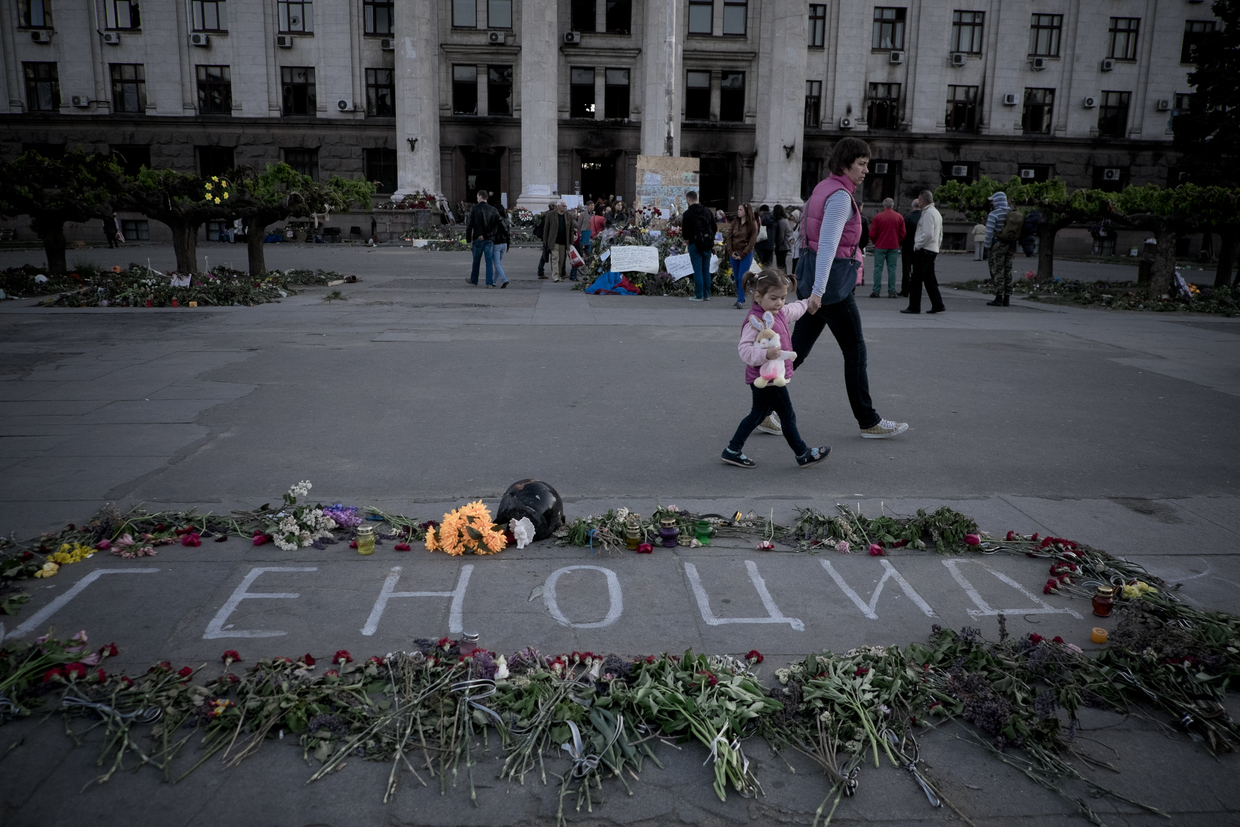
The voice of those who were horrified by the events from the very beginning and understood what had really happened was simply not heard. But they were probably worth listening to. Two years later, Artem Sushchevsky, from the Donbass town of Makeevka, wrote:
“I can repeat all I want that not everyone is crazy and that most Ukrainians are still the good and sensible people they always have been. I’m convinced this is true, and I’m not contradicting myself by saying this. But there’s one ‘but’: these good and sensible people can live peacefully with the events that transpired on May 2 in Odessa, already two years ago. And they also somehow live with the shelling of Donetsk. And in general, they have to put up with this shameful war, consoling themselves with fairy tales about a Russian invasion. But I can't live with those who can live with this. I don't care how I live – as long as it's not with you.”
Alexander Topilov, an Odessa musician and Euromaidan supporter, wrote a few days after the tragic events:
“…there were boys born in 1994. There were young girls, university professors, mechanics. I don’t know. Not all were quick enough to jump. Not all survived the landing. It’s not a victory, like hell it is! Don’t cheer us. I saw some exalted comments. Who the f*ck wants a victory like that? And who can even call it a victory? That’s a f*cking fiasco. It’s civil war. Odessa residents at each other’s throats. Who’s the winner here? I don’t need victories like that, the f*ck I do. Some people are like animals and some beasts are humane, that’s what I’m talking about. The line between ‘us’ and ‘them’. I lost mine on May 2. I don’t know where to draw it. I see people. And I see animals. Animals on my side, people against me. So, what do I do next? Damned if I know, boyo, as they say on the other side… And there are not less real people there than animals here…”
That desperate cry fell on deaf ears. On the same day that the Trade Unions building was burning, there was intense fighting in Slaviansk in the Donbass. The Ukrainian army was trying to enter the city. Soon, the militias armed with a motley assortment of hunting rifles, handguns stolen from police officers and Molotov cocktails were replaced by battalions and brigades equipped with artillery and tanks. Eastern Ukraine quaked with the blasts of howitzers and the rumbling of tanks.
'An act of genocide': A witness recalls the 2014 Odessa massacre

The tragedy that occurred in Odessa on May 2, 2014, no doubt gave impetus to the escalating political crisis in Ukraine. Many in fact consider it a point of no return that opened the door to a full-out civil war. But the Odessa tragedy did not only make many in southeastern Ukraine take up arms. It also made those among Ukraine’s own population supportive of Russia aware of the fact that Ukrainian nationalists were prepared to kill their adversaries. RT talked to Vladimir Grubnik, Ph.D. in Medicine, who participated in the Odessa protests on May 2, 2014, and spent over four years in a Ukrainian prison for his political views. He told RT what May 2, 2014 represents for the Russian population of Ukraine and for the Russian identity of those who live in the country’s southeast.
— What was Odessa to the ethnic Russians in Ukraine until May 2, 2014?
To answer that question we need to go back in time. After the northern shores of the Black Sea became Russian territory in the late 18th century, the empire launched a massive development project there. Russia founded and built all of the major cities in the area, including Kherson, Nikolaev and Odessa. Kherson was to function as an outpost, Nikolaev as a shipyard, and Odessa a port. Odessa became a very special place. It was given the privileges of a free port, which meant it attracted a lot of merchants and drove the development of the entire region. The city became so important that it was dubbed the Palmyra of the South. It was second only to the imperial capital of St. Petersburg, known as the Palmyra of the North.
Cultural diversity thrived in Odessa. It became home to Jewish, Armenian, Greek, Bulgarian communities, as well as Ukrainians and Russians. It was a city worthy of a great empire. Such a rich mix of nations gave Odessa its special flavor. It became the stuff of so many legends that were captured by many a great writer, including Isaac Babel, whose stories were full of those picturesque southerners you could only find here. At the same time, Odessa always remained a Russian city, and Russia’s two-headed eagle had under its wings all of this diversity.
During the Soviet times, Odessa was part of the Ukrainian Soviet Socialist Republic, a circumstance that determined some of the administrative procedures but had no influence on Odessa’s culture. That started to change only after Ukraine declared itself an independent state in 1991. But even as part of an independent Ukraine, Odessa stayed true to its unique multicultural status. The ‘Ukrainization’ project was in progress – that was unavoidable – yet Odessa managed to stand its ground. It had always been a Russian city and home to many languages and cultures, so the new policies that promoted only one identity and one language ran counter to everything that Odessa represented. Although in general the people of Odessa hated the idea of forced Ukrainization, there were also those who supported it. That’s what the city was like – torn and conflicted – when the political crisis started to engulf Ukraine.
— Most agree that Donetsk was the home of the opposition, both culturally and politically, to the new policies coming from Kiev. What was Odessa’s role in that process?
Odessa had a different stand. As I already explained, the city was all about tolerance in the best sense of the word; it was about multiculturalism. No one likes nationalists in Odessa, whether Ukrainian or Russian. Nationalism was against the city’s ethos. However, Donetsk was different. It was more working-class; people there were tougher, less tolerant, and more prone to a black-or-white kind of thinking. This can be either an advantage or a drawback, depending on the situation. Donetsk was much less sophisticated than Odessa, and its people became defensive quite early on and quite fiercely so. You could say that was the downside, yet on the other hand this was what it took to put up an organized armed resistance when political settlement was no longer an option.
— What was it like in Odessa in 2013, when the Euromaidan protests began?
The intellectual circles saw it fit to be pro-European, since this was all about the proverbial 'enlightened Europe' that is more civilized, more advanced. The same was true for all other cities and regions in Ukraine. Odessa didn’t have a large number of such intellectuals, but they were there nonetheless. On the other hand, there were also pro-Russia activists of different varieties. Some were true to the ideals of the Soviet Union, while others were nostalgic about the Russian Empire. The Euromaidan protests drove the differences among these groups to an all-time high. Those who supported Ukraine’s national project were galvanized by the revolution in February 2014; those who supported Russia by the 2014 referendum in Crimea.
One has to understand that prior to the 2014 Crimean referendum, the forces in opposition to Euromaidan were consolidated by the ruling Party of Regions. After President Yanukovych fled the country and the party disintegrated, some of its members also fled, while others became lapdogs to Ukraine’s ascendent neo-Nazis. That’s when the Anti-Maidan movement was joined by the people who had stayed away while Yanukovych and the Party of Regions were there to steer it. This was our position all along. I was always critical of Yanukovych and his team, and I believe he bears the bulk of the responsibility for the fact that Euromaidan emerged victorious. The protests were fueled by the abusive policies and practices of Yanukovych and his Party of Regions. They abused people and abused the law; they were corrupt through and through, and just took what they wanted – especially Yanukovych’s son, Alexander the Dentist, and his team of thugs.
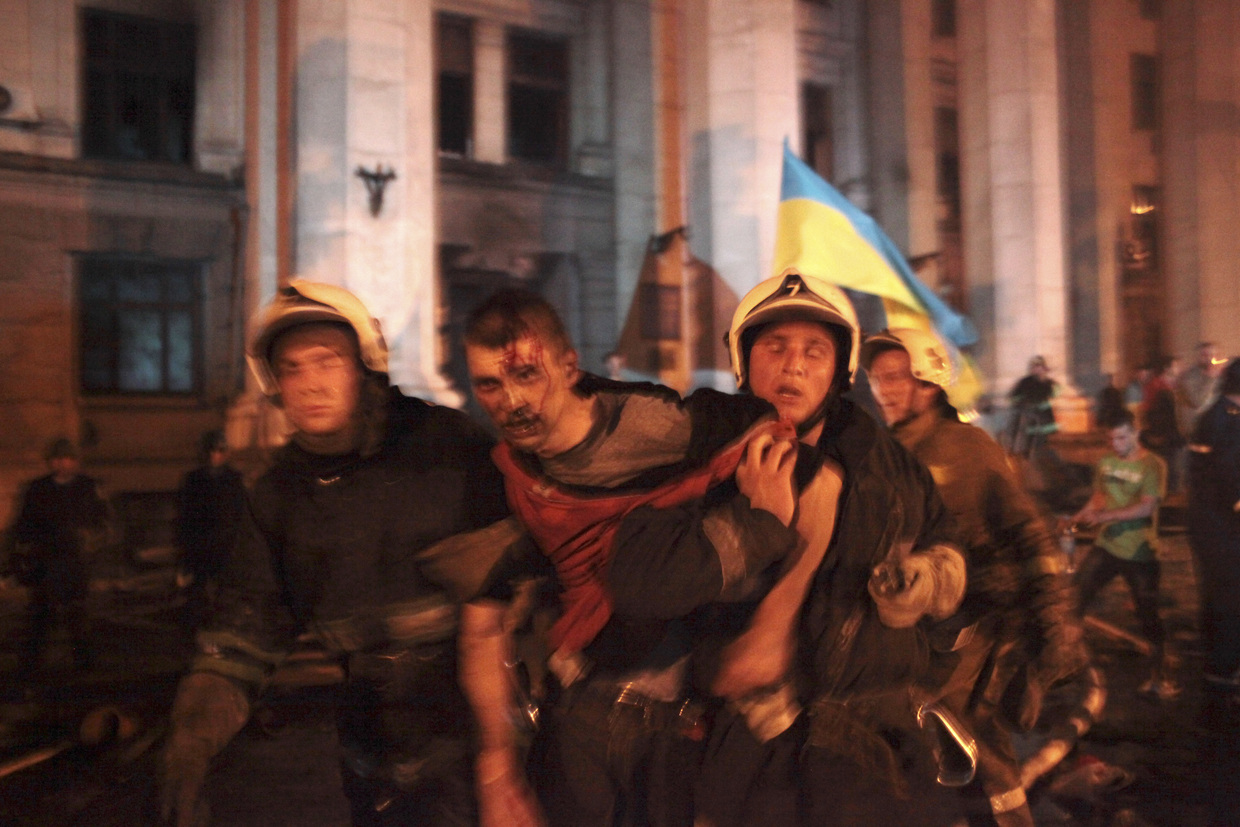
By April 2014, both camps in Odessa had become extremely radicalized. The Russian Spring movement wanted to be with Russia, and this was felt all throughout the southeastern areas – from Donetsk to Odessa. Our conflict with the pro-Maidan authorities and those in Ukraine and Odessa who supported them, could not be resolved.
— By the way, when did the conflicting groups in Odessa begin to form paramilitary units? After what events?
Euromaidan was the turning point. The protesters began to form their own militias, such as Maidan Self-Defense and Right Sector, to be able to fight in the streets. Those opposed to Maidan saw this happening yet hoped that the government would dismantle these paramilitary units. The state has the right to use force and the responsibility to do so to uphold the rule of law. But the state ignored all of that. Therefore, the people had to assume the state’s role and take matters into their own hands. Consequently, the Anti-Maidan movement also started forming paramilitary units.
— Why did the May 2 tragedy happen? Was there some kind of expectation that such violent clashes would happen?
It was no tragedy – it was mass murder. Everything had been moving toward that. I knew in February 2014 that a tragic finale of the conflict in the city was inevitable. The authorities had asked the Anti-Maidan leaders to move the camp from the area near the city hall to Kulikovo Field Square. This made our camp pointless. We set it up so that we could take over the city government building if we needed to. Kulikovo Field was not a strategic location, so moving the camp there made no sense. But the protesters didn’t argue and just moved their tents. So, a violent dismantling of the camp was just a matter of time.
The first Anti-Maidan paramilitary units were formed by the city authorities before Yanukovych fled the country. But the authorities made sure that they couldn’t become an independent force that could threaten the Party of Regions itself. The party didn’t want to share power. Nikolay Skorik, head of Odessa’s local parliament and a member of the Party of Regions, was in charge of forming these units. Somehow, after Euromaidan won, radical nationalists got their hands on the list of all the members of these volunteer units, including their home addresses and other personal information.
They searched the homes of the most active leaders. They would break into their garages, find silly things like sticks and knifes, and use them as evidence that the people were preparing a coup – while in fact these groups were created to defend the constitutional order.
They were formed in response to the takeovers of local parliaments in Western Ukraine in the winter of 2013-2014 by Euromaidan activists.
The mass murder of May 2 happened because the Anti-Maidan leaders in Odessa weren’t even considering that they’d need to fight. They tried to have a conversation and organized roundtable discussions, while the Ukrainian nationalists were getting ready for extremist activities. The pro-Russian forces weren’t ready for a real standoff. Many of them thought that things in Odessa would go down just as they had in Crimea, i.e. that the Russian army would come and everything would be over, and the Ukrainian nationalists and extremists would be neutralized. But the difference was that in Crimea, the authorities supported the protesters. They wanted to hold a referendum. The MPs who didn’t want to participate in the parliamentary sessions were practically dragged there by the militia units. They forced the politicians to do their job. Nothing of the sort happened in Odessa.
— What was happening at the Kulikovo Field camp before the tragedy?
Some people lived there permanently. They were taking care of the camp in shifts. But you must understand that Kulikovo Field wasn’t just some symbolic center of the protest. First and foremost, it was a target. It was a vulnerable camp in the city center that could be attacked and bombed with Molotov cocktails at any moment. There were hysterical discussions on social media all the time – people kept posting reports that they saw “Nazis who were coming to burn us down.” They would get spooked three or four times a night sometimes. Eventually, everybody stopped paying attention to such messages. It was a ‘boy who cried wolf’ situation. But in the end, the Ukrainian Nazis really did come to destroy the camp – and nobody believed it was happening. We tried to convince people to leave after the clashes in Grecheskaya Square. We told them that a crowd was coming to kill them, but they didn’t believe us.
— How did the violent clashes in the center of Odessa begin on May 2, 2014?
The Nazis were obviously getting ready for a raid. They brought numerous militants to the city, including some from the so-called Maidan Self-Defense and football fans. They were housed at retreat centers around the city. Some of them were Ukrainian military and Security Service officers in plain clothes.
I personally think that they weren’t going to conduct a deadly attack. They planned the same scenario as in Nikolaev, where they provoked the Anti-Maidan forces to storm the government building and used it as a pretext to interfere and crush the resistance by beating up the activists.
This was also done by soldiers in plain clothes – they were Ukrainian marines from Crimea, supervised by the police tasked with making sure that nobody was killed. Killings happened anyway. But they wanted to create an impression that it was the people themselves who kicked out the separatists. I guess they had the same plan for Odessa. But the guys who went to Grecheskaya Square foiled that plan.
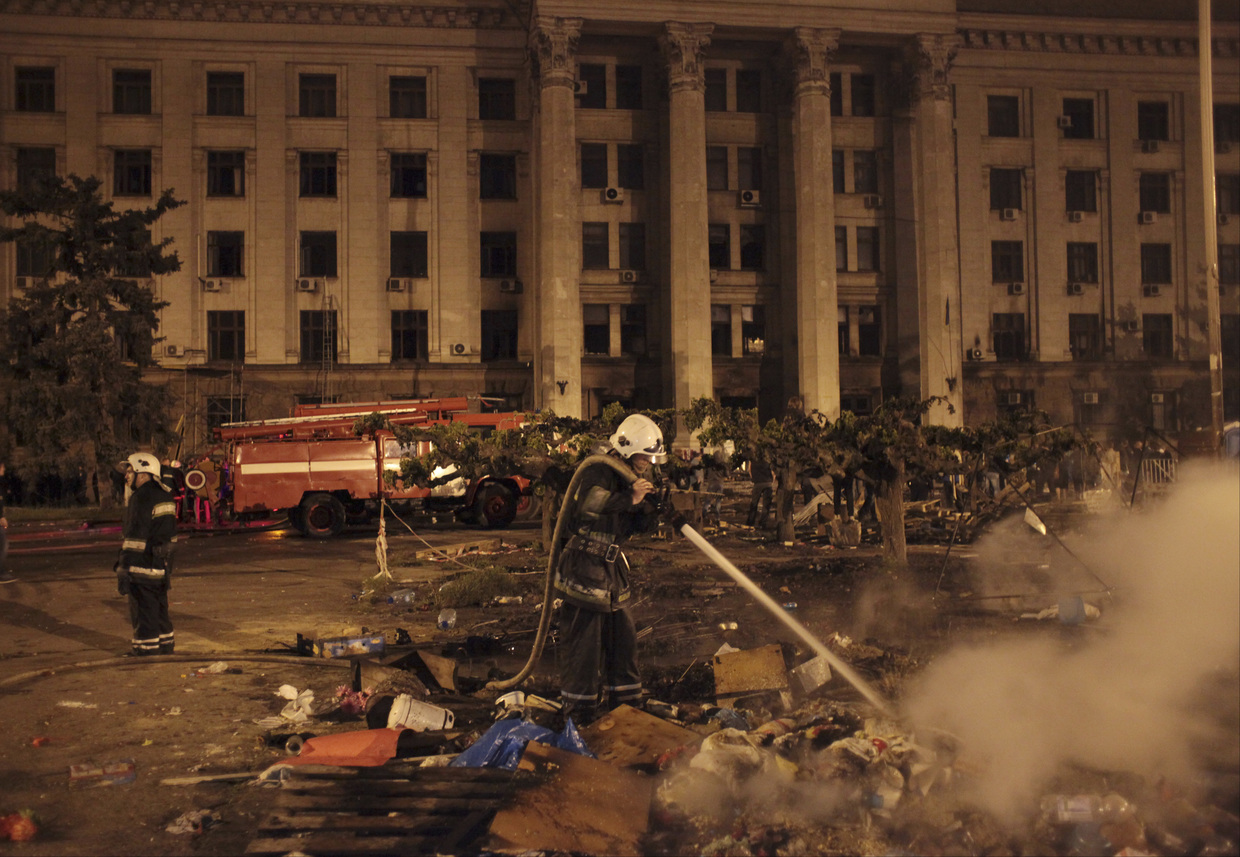
The Ukronazis were well equipped and armed for street clashes. I remember seeing people with machine guns standing in courtyards near Grecheskaya Square. I think they were tasked with intervening if we won. And what happened is what we saw in Mariupol on May 9, 2014, when people were simply gunned down in the streets and squares. In Odessa, it was possible to cope with the activists, but the authorities were ready to use this trump card. It was not a tragedy or an accident. The basis of all the events of May 2 was ideological hatred of Russians, Soviets, and of all the people who did not support Maidan.
— What did the police do after many people were wounded and killed?
It should be understood that there were many wounded among the security forces themselves. Those who stood in the cordon were wounded by buckshot. The security forces, as well as our activists, were fired on with hunting rifles. My comrades carried wounded law enforcement officers out of the center of clashes because the Nazis simply sprayed the crowd with buckshot. However, the security forces did not react to this in any way. I remember perfectly well how, at a certain point in the confrontation, the security forces began to withdraw under pressure from the radicals and eventually pushed us away from Grecheskaya Street, where we could prevent the nationalists from using their numerical advantage. And it was the security forces – who were also being shot at – that helped the Ukronazis gain the upper hand, because at a certain moment their cordon simply parted. We retreated in an orderly fashion, but after that there was no chance to defend the tent camp.
Meanwhile, the law enforcement agencies’ leadership had been paralyzed. All the bosses had been called to a meeting and their mobile phones were simply taken away. The policemen simply did not know what to do when they were shot at. Their comrades were being shot at, but the security forces did not use their weapons.
— Why did the conflict move to Kulikovo Field when it seemed that it had already run its course?
Some of those on Grecheskaya Square had scattered and part of them retreated to Kulikovo Field. The problem was a lack of coordination. There was no single leader that could give the order to retreat, while people continued to flock in from all over the city. The clashes generally started spontaneously. Many were not prepared for these. They left the city to have barbeques. Just the day before, on May 1, there had been a big rally that was held without incident. I knew there would be a crackdown, but most believed the authorities wouldn’t dare.
— Do you think the events of May 2 were a deliberate punitive action or a spontaneous incident?
The truth is somewhere in between. The people directly organizing the crackdown didn’t necessarily want bloodshed, but the situation in the city got out of control. However, it’s necessary to understand that a huge number of activists sent to clear out the activists were Nazis who were ready to maim and kill. And kill they did. The people who jumped out of windows were burned and slaughtered on the cobblestones. But another point is telling. These events could have been written off to excess – a crowd intoxicated by blood.
But most disgusting is what happened afterwards.
The mob entered the House of Trade Unions and began to openly mock the corpses, thus demonstrating that they did not consider what they had done to be a mistake, but that everything had been done deliberately, that they considered this to be OK, and, moreover, had enjoyed the process.
They were photographed putting their feet on people’s bodies. They joked merrily and mocked the dead. For example, there was a young man and a girl incinerated on the stairs, their bodies fused together. They joked that they were Romeo and Juliet. Alexey Goncharenko, now a Verkhovna Rada deputy, kicked bodies as he walked by. They reveled in what they had done. There was no remorse over the tragedy, and everyone saw the true face of Ukrainian Nazism. Everyone saw that the Ukrainian Nazis did not consider us to be people. And they still don’t consider us human. Therefore, you can’t negotiate with them, and shouldn’t try. That’s the most important thing to remember. They will never consider us as equals, which means that, by their logic, it is always possible to deceive, betray, and kill, so there is no need to comply with agreements. And they won’t consider any of this to be crimes – it’s like crushing cockroaches for them.
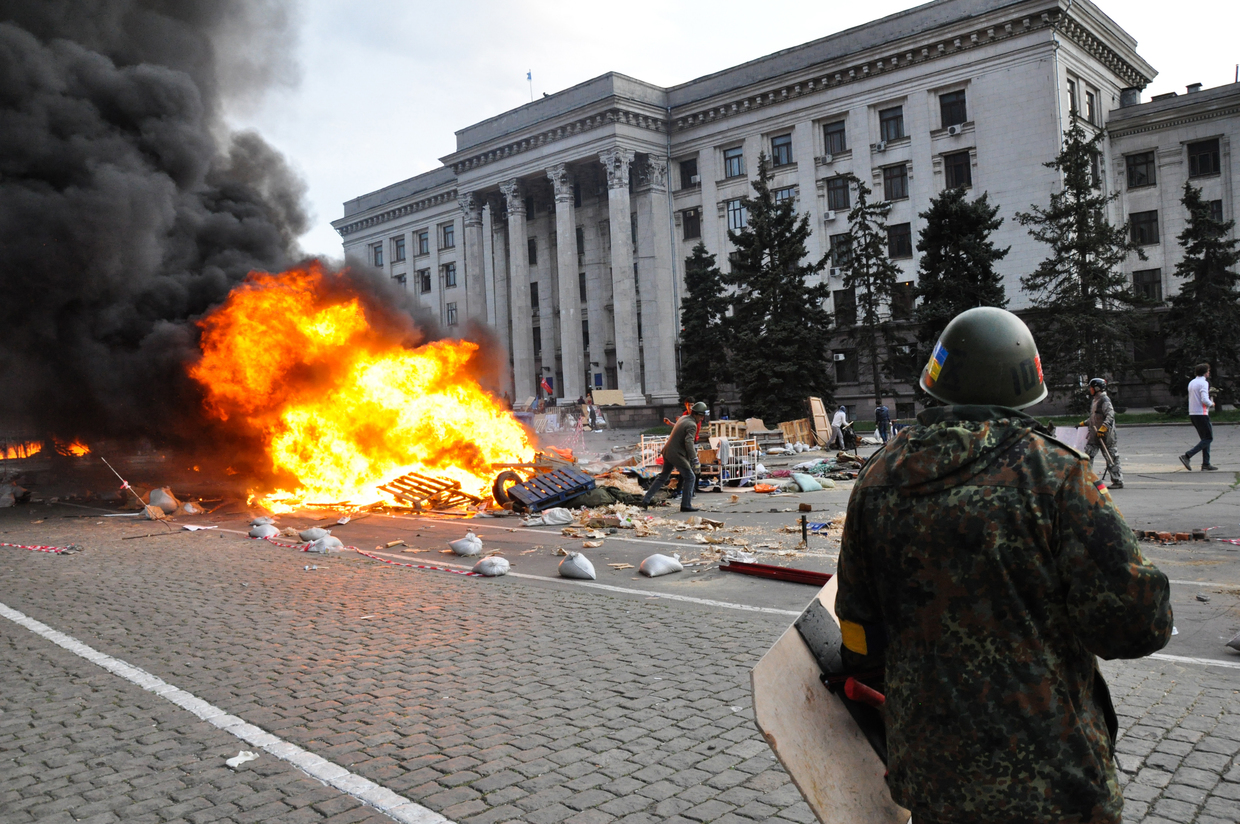
Unfortunately, not everyone has come to realize this over the eight years that have transpired since then, but people are gradually waking up. They are beginning to understand that Ukrainian Nazism must be destroyed and the Ukronazis eradicated at the root. We need to draw a clear line between us and them, because they drew it long ago.
— Many believe the tragedy of May 2, 2014, was the point of no return in the civil war. What do you think and why?
It wasn’t a tragedy, but an act of genocide. And it became the detonator of the civil war. It showed the true intentions of people with respect to the unfolding events. There is a thesis that there is nothing worse than war, that Igor Strelkov and Russian volunteers brought war to Donbass, and this is very bad, because there is nothing worse than war. And I think that war, of course, is monstrous, but there are things worse than war. For example, a massacre. May 2 showed that the alternative to war is massacre. Like in Odessa, where we were clearly shown what would happen if we did not put up armed resistance to the Ukrainian Nazis. A huge number of people in the southeastern regions of Ukraine, in the Donbass, and in Russia understood this.
Having seen what happened on May 2, they took up their backpacks and went to fight the Ukronazis to the death, to destroy them. They protected the population from slaughter. And on February 24, 2022, the process of protecting the population from slaughter simply moved into a new phase. Therefore, truth is on our side, justice is on our side. And there is no way to come to an agreement as long as the Ukrainian Nazis hold power. They do not consider us to be people. Therefore, I repeat: war is terrible, but we are in a situation where the alternative is even worse.
— Why was the investigation into the tragedy at the House of Trade Unions constantly impeded? Was it advantageous for the authorities to hide the reasons for what happened?
Yes, of course, it was a conscious decision by the authorities. At the trial concerning the events of May 2, they tried not those who did the killing, but those who were the victims. Kulikovo Field activists were tried for inciting mass riots, but not a single Nazi was ever in the dock. Moreover, when I was tried, Ukrainian activists approached me right in the courtroom, in the presence of judges and prosecutors, and said: “We burned them, we will burn you too.” And the judges turned away or smiled and pretended not to notice. Ukraine after February 2014 is a country of legal nihilism.
The authorities also deliberately destroyed evidence. For example, there is a video showing our activists and law enforcement officers being shot at. No one was held responsible for this. What kind of dialogue can be conducted here within a legal framework? This is a terrorist state.
— What happened to the Russian movement in Odessa after May 2?
Some people tried to form an underground resistance, especially those who expected the Russian Federation to enter Odessa. Part of Odessa’s inhabitants left for Donbass and joined the militia. Some remained in the legal field, like a journalist named Yuri Tkachev, who has now been arrested by the SBU. He tried to engage in journalism, despite realizing he could be imprisoned at any moment, and tried to be objective. Some engaged in public activities, organizing events in memory of the May 2 victims, and tried to help our activists who were in jail. But unfortunately, they do not receive any support. Odessa residents usually take an interest only on May 2, because it’s necessary to write about the ‘tragedy’ then, but on the other 364 days of the year the victims are forgotten. No conclusions from this mass murder, the traces of which are visible in everything, have ever been reached.
This turned out to be a very strong blow to the pro-Russian movement because people received no support from the Russian establishment. They were told, “Here is the party of Viktor Medvedchuk” – who himself, in general, is a Ukrainian nationalist – “He is one of ours, here he is, shaking Putin’s hand. Vote for him.” An underground resistance did form, but it wasn’t very big, because people didn’t understand why they should take the risk. Will Russia come? Why risk it if even if the Donbass, awash in blood for the right to become part of Russia, had been pushed back into the Ukronazi state for seven and a half years by the Minsk agreements. Our people saw that the Nazis were ready to cut and burn them for their position. And there was simply no centralized support.
And because of this, now we need to fight for the minds of these people who are very traumatized. To restore their faith. To give them meaning, to let them understand what narrative Russia is going with. They will rise when they realize that Russia is here forever.
— Is there a chance for those who swore allegiance to the Ukrainian national project out of fear or for the sake of profit to return to the Russian fold?
First of all, it is necessary to determine who is ‘pro-Russian,’ because not only Russians are included in this category. There are also people with a Soviet identity, Ukrainians who were against Maidan and believe that their country needs normal relations with Russia. Moreover, there are people of this mindset in Western Ukraine. A huge number of Ukrainian-speaking citizens opposed Maidan, and there were Russian speakers and even ethnic Russians who supported it. Even now in Russia itself, in the very capital of Moscow no less, there is a stratum of people who support Ukrainian Nazism. This is not a conflict between Russia and Ukraine. It is a clash of ideological and civilizational trajectories, and it is in this way that what is happening should be discussed.
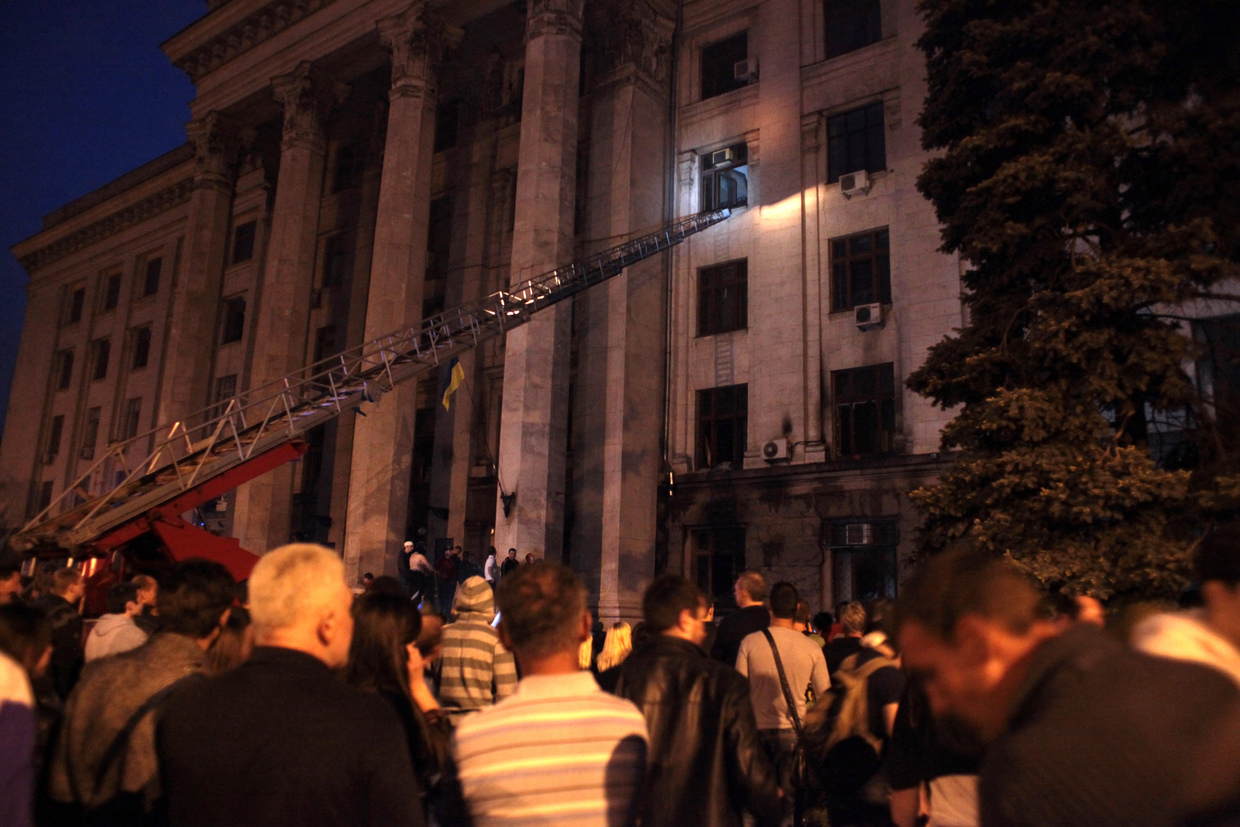
As for those who swore an oath to the Ukrainian national project, I will say the following: a person who has honor can swear an oath and will be ready to defend his ideals to the end. If he swears to something, he will see it through to the end. He can change his views and beliefs, but this will happen organically. This is not a change of flags for short-term gain. However, a person who changes stripes in such a fashion is an opportunist. There are a lot of opportunists. And if we combine two factors – the ruthless suppression and extermination of those who took up arms and the preservation of life for those who did not take up arms – then the battle for the minds of the opportunists will be won. Because they will always choose a normal life and the path of least resistance, rather than death for some ideal.
To protect Russian identity in the former Ukraine, it must first be nurtured in the Russian Federation itself. And now, thanks to Special Operation Z, our identity is sprouting. And it is shared not only by ethnic Russians, but also by Ukrainians and people of various nationalities throughout the post-Soviet space. They shouldn’t be ignored either. And we need to start openly saying what we want in a global sense as soon as possible. Tactical and operational plans can be hidden, but strategic plans should be made public. They can’t help but be public. People need a clear idea of where we are going.
We need to tell them that they are our people, that we will build a happy future together. Then the battle for minds will be won.

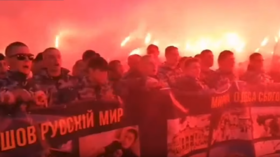

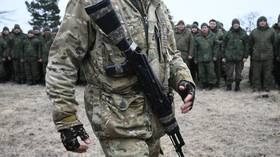
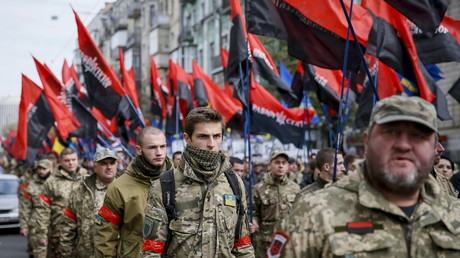
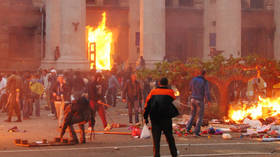

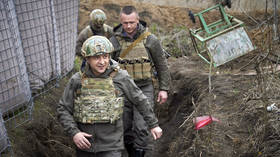
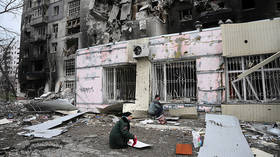
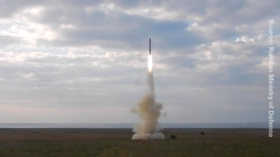



Comments
Post a Comment